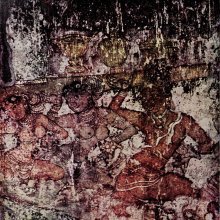Taste: 1 definition
Introduction:
Taste means something in Hinduism, Sanskrit. If you want to know the exact meaning, history, etymology or English translation of this term then check out the descriptions on this page. Add your comment or reference to a book if you want to contribute to this summary article.
Images (photo gallery)
In Hinduism
Yoga (school of philosophy)
Source: ORA: Amanaska (king of all yogas): A Critical Edition and Annotated Translation by Jason Birch(That which is) Taste is denoted by the Sanskrit term Rasa (as opposed to Arasa—‘tasteless’), according to the Bṛhadāraṇyikopaniṣat 3.8.6.—Accordingly, while describing the absolute nature of Brahma: “Gārgi said, ‘Yājñavalkya, that which is above the sky, below the earth, between the two and called [past, present and future], is stitched and cross-stitched in what?’ Yājñavalkya said, ‘Gārgi, the Brahmins call that very [thing] the imperishable one. [e.g., It is tasteless (arasa) [...]’”.

Yoga is originally considered a branch of Hindu philosophy (astika), but both ancient and modern Yoga combine the physical, mental and spiritual. Yoga teaches various physical techniques also known as āsanas (postures), used for various purposes (eg., meditation, contemplation, relaxation).
See also (Relevant definitions)
Starts with: Tasteless, Tastelessness.
Ends with: Control over taste, Pataste.
Full-text (+1491): Rasa, Ruci, Tikta, Shvada, Rasajna, Amla, Svad, Amlarasa, Asvada, Rasika, Abhiruci, Rasantara, Arasika, Rasavid, Svadu, Rasanivritti, Madhura, Rasana, Lavana, Rasotpatti.
Relevant text
Search found 399 books and stories containing Taste; (plurals include: Tastes). You can also click to the full overview containing English textual excerpts. Below are direct links for the most relevant articles:
Charaka Samhita (English translation) (by Shree Gulabkunverba Ayurvedic Society)
Chapter 26 - Discussion among Sages regarding Tastes (Rasa) < [Sutrasthana (Sutra Sthana) — General Principles]
Chapter 1 - The Measure of Tastes (rasa-vimana) < [Vimanasthana (Vimana Sthana) — Section on Measure]
Chapter 2 - The blossoming of prognostic symptoms (pushpitaka) < [Indriyasthana (Indriya Sthana) — Section on Sensorial Prognosis]
Sushruta Samhita, volume 1: Sutrasthana (by Kaviraj Kunja Lal Bhishagratna)
Chapter XLII - Knowledge of tastes of drugs
Chapter XL - Knowledge of taste etc of drugs
Brihad Bhagavatamrita (commentary) (by Śrī Śrīmad Bhaktivedānta Nārāyana Gosvāmī Mahārāja)
Verse 2.4.190 < [Chapter 4 - Vaikuṇṭha (the spiritual world)]
Verse 2.3.161 < [Chapter 3 - Bhajana (loving service)]
Verse 2.3.160 < [Chapter 3 - Bhajana (loving service)]
Maha Prajnaparamita Sastra (by Gelongma Karma Migme Chödrön)
Section A.4 - Rejecting pleasant tastes < [Part 2 - Means of acquiring meditation]
Section A.1 - Rejecting colors < [Part 2 - Means of acquiring meditation]
Story of the crown prince who was poisoned by fruit < [Part 2 - Means of acquiring meditation]
Rasa Jala Nidhi, vol 2: Minerals (uparasa) (by Bhudeb Mookerjee)
Notes on the five tastes (sweet, sour, salty, pungent, bitter, astringent) < [Notes]
Part 1 - Characteristics of Shilajatu or Shilajit (bitumen) < [Chapter IV - Uparasa (4): Shilajatu or Shilajit (bitumen)]
Part 1 - Characteristics of Kasisa (sulphate of iron) < [Chapter X - Uparasa (11): Kasisa (sulphate of iron)]
Bhagavati-sutra (Viyaha-pannatti) (by K. C. Lalwani)
Part 1 - On astikāyas < [Chapter 10]
Part 2 - On monks (nirgrantha) < [Chapter 1]
Chapter 1: Life in Utpala < [Book 11]
Related products
(+72 more products available)






